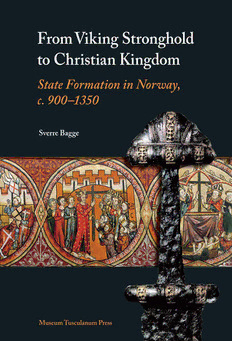
From Viking Stronghold to Christian Kingdom: State Formation in Norway, c.900 - 1350 PDF
Preview From Viking Stronghold to Christian Kingdom: State Formation in Norway, c.900 - 1350
From Viking Stronghold to Christian Kingdom State Formation in Norway, c. 900–1350 Sverre Bagge Museum Tusculanum Press From Viking Stronghold to Christian Kingdom For Matilde From Viking Stronghold to Christian Kingdom State Formation in Norway, c. 900-1350 Sverre Bagge Museum Tusculanum Press University of Copenhagen 2010 From Viking Stronghold to Christian Kingdom: State Formation in Norway, c. 900-1350 © Museum Tusculanum Press and Sverre Bagge, 2010 Consultant: Niels Lund Copy editor: Jordy Findanis Cover design: Erling Lynder Set and printed by AKA-PRINT A/S ISBN 978 87 635 0791 2 Cover illustrations: Upper register of the frontal from the church at Nedstryn, Western Norway, ca. 1315. It depicts the Persian king Chosroes capturing the Holy Cross and his defeat by the Byzantine emperor Heraclius. The narrative sequence shows: 1) Heraclius decapitating Chosroes, 2) Heraclius triumphantly riding with the Cross to Jerusalem, 3) Heraclius, barefoot and humble, carrying the Cross through the gates, 4) The elevation of the Cross on the altar. Photo: Svein Skare, Bergen Museum. Viking Age animal head post from the Oseberg burial, Tønsberg, Vestfold, Museum of Cultural History, University of Oslo, Norway. Photo: Ove Holst. Viking Age sword from Steinsvik, Hol, Nordland, Museum of Cultural History, University of Oslo, Norway. Photo: Eirik Irgens Johnsen. This book is published with financial support from Centre for Medieval Studies, University of Bergen The Research Council of Norway Museum Tusculanum Press 126 Njalsgade DK-2300 Copenhagen S Denmark www.mtp.dk Contents 9 Preface 11 Introduction 21 The Formation of the Kingdom of Norway The Rise of the Scandinavian Kingdoms 23 From Harald Finehair to Harald Hardrada 25 Unification and Division – the Moving Forces 33 External and Internal Factors 39 The “Civil Wars” 40 Pretenders and Factions 42 The Basic Factors 47 The Consequences of the Civil Wars 53 From the Civil Wars to the Age of Greatness 66 69 War, Military Organisation and Social Change From Plunder to Internal Exploitation 69 The Origin and Development of the leidang 72 Leidang and Elite Forces 79 The Norwegian Empire and its Foreign Policy until 1319 85 War Made the State, but Did the State Make War? – The Military Challenges 1240-1319 101 The Social and Economic Basis of the Norwegian Military System 110 The Towns – Centres of the Monarchy and the Church 121 The King’s Revenues 126 Conclusion 133 137 Religion, Monarchy, and the Right Order of the World Old Norse Religion 137 The Conversion to Christianity 148 The Right Order of the World and the Christian Monarchy 157 The Emergence of the Dynasty and Hereditary Monarchy 165 The Courtly Culture 170 Patriotism and Secular Legitimation of Monarchy 174 Conclusion 177 179 Justice, Law and Power The Regional Laws 179 What Was Law? 182 Law and Society 190 God’s Law: The Rise of Royal and Ecclesiastical Jurisdiction 195 Royal and Ecclesiastical Legislation: A New Concept of Law 201 The Emergence of Public Justice: Intent and Evidence 206 Justice in Practice 215 A Legal Revolution? 220 Conclusion 226 Royal and Ecclesiastical Administration 229 – a Step towards a Real Bureaucracy? The Ecclesiastical Administration 229 The Royal Administration 233 A New Bureaucracy? 238 From Oral to Written Administration 243 Writing in the Royal Administration: The Quantitative Evidence 250 Writing in the Royal Administration: The Qualitative Evidence 256 Predictability and Distance 267 The Leaders: King and Bishop 272 Did Norway Become a State? Government, Obedience and Clientelism 282 Conclusion 291 293 The Division of Power and its Social Foundation The King and the Church: From the Foundation of the Church Province to the Death of Håkon Håkonsson 294 The Conflict about Jurisdiction and the Concordat of Tønsberg 297 The Conflict in the 1280s 303 The Results of the Struggle – Monarchy and Church in the Fourteenth Century and Later 312 The Ideological Aspect: A Brain Trust in the Service of the Monarchy 316 Regnum and Sacerdotium in Norway 319 The Secular Aristocracy 324 The King and the Aristocracy: Ideology 329 From Assemblies of the Best Men to the King’s Council 335 Who Were “The Best Men”? 340 The Decision-Making Process 342 The Problem of Regencies 356 Monarchy, Aristocracy and Union during the Reign of Magnus Eriksson 360 A Strong Monarchy 365 The King and the People 371 Conclusion 375 How, Why, When and How Much? The Extent and Character 379 of Norwegian State Formation in the Middle Ages 389 The Kings of Norway, c. 900-1380 391 Literature, Sources and Abbreviations 431 Index Preface This book forms part of the projects Periphery and Centre in Medieval Europe and The Nordic Countries and the Medieval Expansion of Europe. New Interpretations of a Common Past, which are carried out currently by the Centre for Medieval Studies at the University of Bergen and the Nordic Centre for Medieval Studies at the Universities of Bergen, Gothenburg, Odense and Helsinki and funded respectively by The Research Council of Norway and NOS-HS. Although mainly focused on Norway, the book is also intended as a contribution to the general discussion of medieval state formation and the importance of Scandinavia in this context. During the period of writing, I have profited greatly from the stimulat- ing atmosphere of these two research centres and from discussion with and advice from colleagues in Bergen and within the Nordic network. In particular, I want to thank the members of the State Team within the Nordic Centre: Thomas Lindkvist, Leidulf Melve, Lars Hermanson, Erik Opsahl, Auđur Magnúsdóttir, Antoaneta Granberg, Geir Atle Ersland, Frode Hervik, Ildar Garipzanov, Thomas Foerster and John Lind, who have read and commented on the manuscript or parts of it. I am also grateful to Niels Lund and Jørn Øyrehagen Sunde for useful comments and to Jena Habegger-Conti for correcting my English. Sverre Bagge Bergen, October 2009
